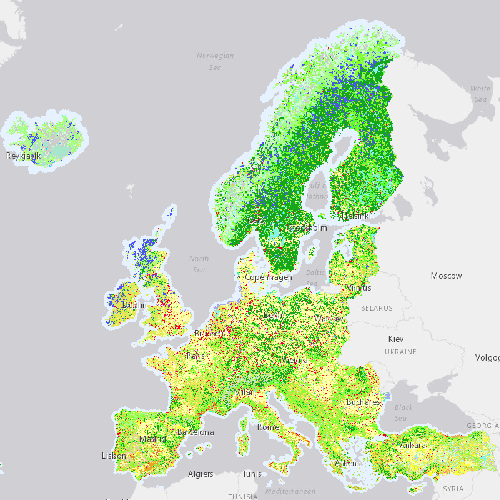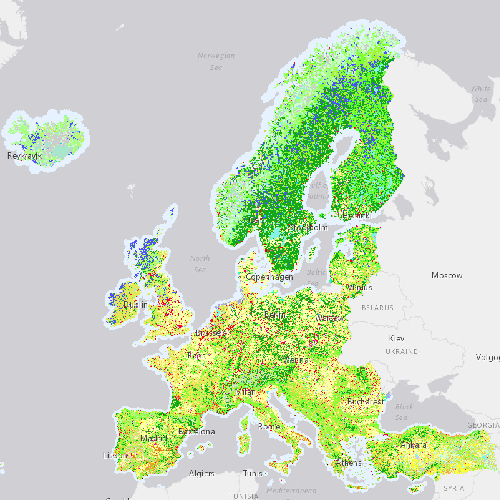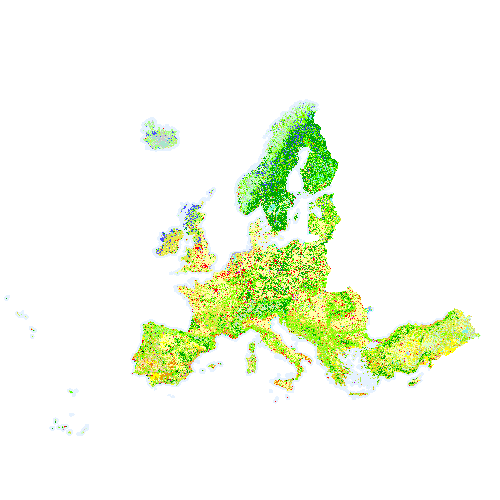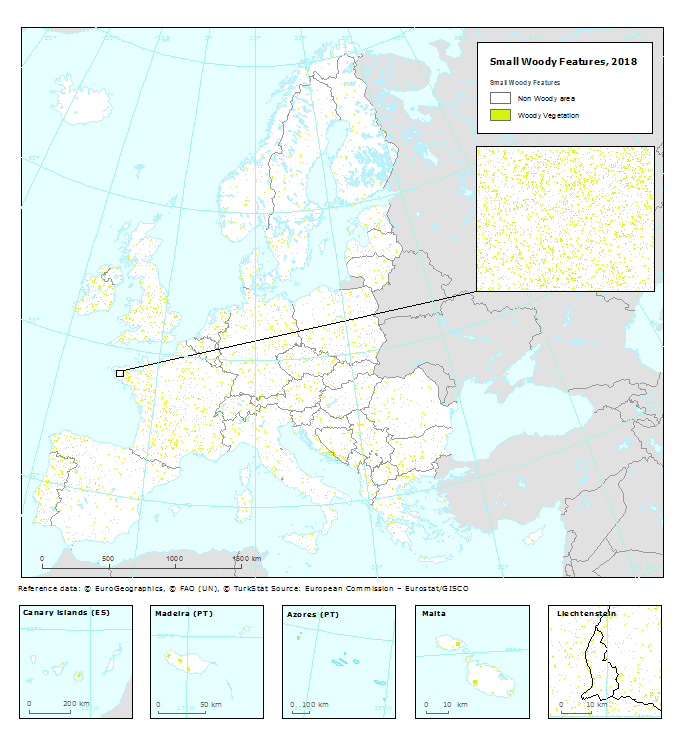landscape
Type of resources
Available actions
Topics
Keywords
Contact for the resource
Provided by
Years
Formats
Representation types
Update frequencies
status
Service types
Resolution
-

Corine Land Cover 2012 (CLC2012) is one of the Corine Land Cover (CLC) datasets produced within the frame the Copernicus Land Monitoring Service referring to land cover / land use status of year 2012. CLC service has a long-time heritage (formerly known as "CORINE Land Cover Programme"), coordinated by the European Environment Agency (EEA). It provides consistent and thematically detailed information on land cover and land cover changes across Europe. CLC datasets are based on the classification of satellite images produced by the national teams of the participating countries - the EEA members and cooperating countries (EEA39). National CLC inventories are then further integrated into a seamless land cover map of Europe. The resulting European database relies on standard methodology and nomenclature with following base parameters: 44 classes in the hierarchical 3-level CLC nomenclature; minimum mapping unit (MMU) for status layers is 25 hectares; minimum width of linear elements is 100 metres. Change layers have higher resolution, i.e. minimum mapping unit (MMU) is 5 hectares for Land Cover Changes (LCC), and the minimum width of linear elements is 100 metres. The CLC service delivers important data sets supporting the implementation of key priority areas of the Environment Action Programmes of the European Union as e.g. protecting ecosystems, halting the loss of biological diversity, tracking the impacts of climate change, monitoring urban land take, assessing developments in agriculture or dealing with water resources directives. part of the European Copernicus Programme coordinated by the European Environment Agency, providing environmental information from a combination of air- and space-based observation systems and in-situ monitoring.
-

Corine Land Cover Change 2006-2012 (CHA0612) is one of the Corine Land Cover (CLC) datasets produced within the frame the Copernicus Land Monitoring Service referring to changes in land cover / land use status between the years 2006 and 2012. CHA is derived from satellite imagery by direct mapping of changes taken place between two consecutive inventories, based on image-to-image comparison. CLC datasets are based on the classification of satellite images produced by the national teams of the participating countries - the EEA members and cooperating countries (EEA39). National CLC inventories are then further integrated into a seamless land cover map of Europe. The resulting European database relies on standard methodology and nomenclature with following base parameters: 44 classes in the hierarchical 3-level CLC nomenclature; minimum mapping unit (MMU) for status layers is 25 hectares; minimum width of linear elements is 100 metres. Change layers have higher resolution, i.e. minimum mapping unit (MMU) is 5 hectares for Land Cover Changes (CHA), and the minimum width of linear elements is 100 metres. The CLC service delivers important data sets supporting the implementation of key priority areas of the Environment Action Programmes of the European Union as e.g. protecting ecosystems, halting the loss of biological diversity, tracking the impacts of climate change, monitoring urban land take, assessing developments in agriculture or dealing with water resources directives. part of the European Copernicus Programme coordinated by the European Environment Agency, providing environmental information from a combination of air- and space-based observation systems and in-situ monitoring.
-

Land cover classification image for the Aspen Parkland ecoregion of Saskatchewan with a spatial resolution of 10m. The goal of this land cover classification was to distinguish native from tame grasslands. The classification was based on Sentinel-1 and Sentinel-2 imagery using machine learning analysis in the Google Earth Engine platform. The classification was conducted on imagery acquired in 2022, and the classification model was built with field data collected in 2020 - 2022. There are eight classes in total: native grassland, tame grassland, mixed/altered grassland, cropland, shrubs, trees, water, and urban area. Download: here The Prairie Landscape Inventory (PLI) aims to develop improved methods of assessing land cover and land use for conservation. Native grassland has historically been one of the hardest to map at-risk ecosystems because of the challenges in distinguishing native grassland from tame grassland land cover using remotely sensed imagery. This classification distinguishes native grassland from tame grassland and will provide valuable information for habitat suitability for native grassland species, identifying high biodiversity potential and invasion risk potential. The classification map has eight (8) classes: 1. Cropland This class represents all cultivated areas with crop commodities, including corn, pulse, soybeans, canola, grains, and summer-fallow. 2. Native grassland This class represents the native grassland areas that are composed of at least 75% native grass, sedge and forb species, such as the needle grasses and wheatgrasses along with June grass and blue grama grass. Unbroken grassland that is invaded by species like Kentucky bluegrass, crested wheatgrass or smooth brome, such that native cover is less than 75%, is not considered native for the purpose of this project. 3. Mixed/altered grassland This class represents a grassland with a mix of less than 75% native grass, sedge and forb species or less than 75% tame species. These are grassland areas that do not fit into either of the native or tame grassland definitions. 4. Tame grassland This class represents the tame grassland areas that are composed of at least 75% seeded or planted species with introduced grasses and forb species such as crested wheatgrass, smooth brome, Kentucky bluegrass, alfalfa, and sweet clover. 5. Water This class represents permanent water locations such as lakes and rivers. 6. Shrubs This class represents the sites dominated by woody vegetation of relatively low height (generally +/-2 meters) with shrub canopy typically >20% of total vegetation cover. 7. Trees This class represents the coniferous/deciduous trees, mixed-wood area, and other trees >2 meters height with tree canopy typically >20% of total vegetation cover. 9. Urban area This class represents both urban municipalities and buffered roads. Urban municipalities was used to mask the urban/developed area class of the Annual Crop Inventory 2021 (Agriculture Agri-Food Canada). Colour Classes: Value Label Red Green Blue 1 Cropland 255 255 190 2 Native grassland 168 168 0 3 Mixed/altered grassland 199 215 158 4 Tame grassland 245 202 122 5 Water 190 232 255 6 Shrubs 205 102 153 7 Trees 66 128 53 9 Urban area 128 128 128 Accuracy metrics This model has an overall accuracy of 73 per cent. The table below summarizes the user’s accuracy, producer’s accuracy, and F1-score of the model on the validation dataset. Class User’s accuracy (%) Producer’s accuracy (%) F1-score Cropland 91.2 94.5 0.93 Native grassland 74.8 73.1 0.74 Mixed grassland 44.7 44.1 0.44 Tame grassland 67.9 72.8 0.70 Water 94.8 91.3 0.93 Shrubs 61.2 51.1 0.56 Trees 89.7 94.6 0.92
-

Corine Land Cover Change 2000-2006 (CHA0006) is one of the Corine Land Cover (CLC) datasets produced within the frame the Copernicus Land Monitoring Service referring to changes in land cover / land use status between the years 2000 and 2006. CHA is derived from satellite imagery by direct mapping of changes taken place between two consecutive inventories, based on image-to-image comparison. CLC service has a long-time heritage (formerly known as "CORINE Land Cover Programme"), coordinated by the European Environment Agency (EEA). It provides consistent and thematically detailed information on land cover and land cover changes across Europe. CLC datasets are based on the classification of satellite images produced by the national teams of the participating countries - the EEA members and cooperating countries (EEA39). National CLC inventories are then further integrated into a seamless land cover map of Europe. The resulting European database relies on standard methodology and nomenclature with following base parameters: 44 classes in the hierarchical 3-level CLC nomenclature; minimum mapping unit (MMU) for status layers is 25 hectares; minimum width of linear elements is 100 metres. Change layers have higher resolution, i.e. minimum mapping unit (MMU) is 5 hectares for Land Cover Changes (CHA), and the minimum width of linear elements is 100 metres. The CLC service delivers important data sets supporting the implementation of key priority areas of the Environment Action Programmes of the European Union as e.g. protecting ecosystems, halting the loss of biological diversity, tracking the impacts of climate change, monitoring urban land take, assessing developments in agriculture or dealing with water resources directives. part of the European Copernicus Programme coordinated by the European Environment Agency, providing environmental information from a combination of air- and space-based observation systems and in-situ monitoring.
-

Corine Land Cover 2006 (CLC2006) is one of the Corine Land Cover (CLC) datasets produced within the frame the Copernicus Land Monitoring Service referring to land cover / land use status of year 2006. CLC service has a long-time heritage (formerly known as "CORINE Land Cover Programme"), coordinated by the European Environment Agency (EEA). It provides consistent and thematically detailed information on land cover and land cover changes across Europe. CLC datasets are based on the classification of satellite images produced by the national teams of the participating countries - the EEA members and cooperating countries (EEA39). National CLC inventories are then further integrated into a seamless land cover map of Europe. The resulting European database relies on standard methodology and nomenclature with following base parameters: 44 classes in the hierarchical 3-level CLC nomenclature; minimum mapping unit (MMU) for status layers is 25 hectares; minimum width of linear elements is 100 metres. Change layers have higher resolution, i.e. minimum mapping unit (MMU) is 5 hectares for Land Cover Changes (LCC), and the minimum width of linear elements is 100 metres. The CLC service delivers important data sets supporting the implementation of key priority areas of the Environment Action Programmes of the European Union as e.g. protecting ecosystems, halting the loss of biological diversity, tracking the impacts of climate change, monitoring urban land take, assessing developments in agriculture or dealing with water resources directives. part of the European Copernicus Programme coordinated by the European Environment Agency, providing environmental information from a combination of air- and space-based observation systems and in-situ monitoring.
-

The Woody Vegetation Layer is a new product that aims at providing information about presence or absence of woody vegetation of any type across Europe without any differentiation of height, size or nature and without masking forested areas. It includes isolated trees or permanent crops such as orchards. This helps users understand the distribution of these features across different regions and provide an “all tree layer” that users can use to derive their own application. The production of the HRL Small Landscape Features is coordinated by EEA in the frame of Copernicus, the Earth observation component of the European Union’s Space programme. The product is a raster dataset with 5-meter grid spacing (spatial resolution), distributed as 100 x 100 km tiles that are fully conformant with the EEA reference grid.
-

Corine Land Cover 2018 (CLC2018) is one of the Corine Land Cover (CLC) datasets produced within the frame the Copernicus Land Monitoring Service referring to land cover / land use status of year 2018. CLC service has a long-time heritage (formerly known as "CORINE Land Cover Programme"), coordinated by the European Environment Agency (EEA). It provides consistent and thematically detailed information on land cover and land cover changes across Europe. CLC datasets are based on the classification of satellite images produced by the national teams of the participating countries - the EEA members and cooperating countries (EEA39). National CLC inventories are then further integrated into a seamless land cover map of Europe. The resulting European database relies on standard methodology and nomenclature with following base parameters: 44 classes in the hierarchical 3-level CLC nomenclature; minimum mapping unit (MMU) for status layers is 25 hectares; minimum width of linear elements is 100 metres. Change layers have higher resolution, i.e. minimum mapping unit (MMU) is 5 hectares for Land Cover Changes (LCC), and the minimum width of linear elements is 100 metres. The CLC service delivers important data sets supporting the implementation of key priority areas of the Environment Action Programmes of the European Union as e.g. protecting ecosystems, halting the loss of biological diversity, tracking the impacts of climate change, monitoring urban land take, assessing developments in agriculture or dealing with water resources directives. part of the European Copernicus Programme coordinated by the European Environment Agency, providing environmental information from a combination of air- and space-based observation systems and in-situ monitoring.
-

Corine Land Cover 2000 (CLC2000) is one of the datasets produced within the frame the Corine Land Cover programme referring to land cover / land use status of year 2000. The Corine Land Cover (CLC) is a European programme, coordinated by the European Environment Agency (EEA), providing consistent and thematically detailed information on land cover and land cover changes across Europe. CLC products are based on the classification of satellite images by the national teams of the participating countries - the EEA member and cooperating countries (EEA39). National CLC inventories are further integrated into a seamless land cover map of Europe. The resulting European database relies on standard methodology and nomenclature with following base parameters: 44 classes in the hierarchical 3-level CLC nomenclature; minimum mapping unit (MMU) for status layers is 25 hectares; minimum width of linear elements is 100 metres. Change layers have higher resolution, i.e. minimum mapping unit (MMU) is 5 hectares for Land Cover Changes (LCC), and the minimum width of linear elements is 100 metres. The CLC programme provides important data sets supporting the implementation of key priority areas of the Environment Action Programmes of the European Community as e.g. protecting ecosystems, halting the loss of biological diversity, tracking the impacts of climate change, monitoring urban land take, assessing developments in agriculture and implementing the EU Water Framework Directive. run by the European Commission and the European Environment Agency, which provides environmental information from a combination of air- and space-based observation systems and in-situ monitoring.
-

Small Woody Features are important vectors of biodiversity and provide information on fragmentation of habitats with a direct potential for restoration while also providing a link to hazard protection and green infrastructure, amongst others. Optical VHR coverage over Europe 2021 was made available in the ESA Copernicus DWH and, together with Sentinel 2 was the main data source for the detection of small woody features identifiable within the given image resolution. The Small Woody Features Density 2021 with a 100m pixel resolution is derived from a pixel aggregation of the binary Small Woody Features 2021 (10m) status layer. The production of the HRL Small Landscape Features is coordinated by EEA in the frame of Copernicus, the Earth observation component of the European Union’s Space programme. The product is a raster dataset with 100-meter grid spacing (spatial resolution), distributed as a single raster file with European extent.
-

High Resolution land cover characteristics for the 2018 reference year. Small woody landscape features are important vectors of biodiversity and provide information on fragmentation of habitats with a direct potential for restoration while also providing a link to hazard protection and green infrastructure, amongst others. VHR_IMAGE_2018 made available in the ESA Copernicus DWH will be the main data source for the detection of small woody features identifiable within the given image resolution. The Small Woody Features (SWFs) layer contains woody linear and patchy elements but will not be further differentiated into trees, hedges, bushes and scrub. The spatial pattern shall be limited to linear structures and isolated patches on the basis of geometric characteristics.
 Arctic SDI catalogue
Arctic SDI catalogue